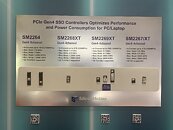
Kioxia Introduces Industry's First UFS Ver. 4.0 Embedded Flash Memory Devices for Automotive Applications
Kioxia Corporation, a world leader in memory solutions, today announced sampling of the industry's first Universal Flash Storage (UFS) Ver. 4.0 embedded flash memory devices designed for automotive applications. These new, higher performing devices deliver fast embedded storage transfer speeds in a small package size and are targeted to a variety of next-generation automotive applications, including telematics, infotainment systems and ADAS. The improved performance] of UFS products from Kioxia - including approximately +100% for sequential read speed and approximately +40% for sequential write speed - enables these applications to take advantage of 5G's connectivity benefits, leading to faster system startup times and a better user experience.
The first to introduce UFS technology, Kioxia continues to move the technology forward. Its new UFS Ver. 4.0 devices integrate the company's innovative BiCS FLASH 3D flash memory and a controller in a JEDEC-standard package. UFS 4.0 incorporates MIPI M-PHY 5.0 and UniPro 2.0 and supports theoretical interface speeds of up to 23.2 Gbps per lane or 46.4 Gbps per device. UFS 4.0 is backward compatible with UFS 3.1.
The first to introduce UFS technology, Kioxia continues to move the technology forward. Its new UFS Ver. 4.0 devices integrate the company's innovative BiCS FLASH 3D flash memory and a controller in a JEDEC-standard package. UFS 4.0 incorporates MIPI M-PHY 5.0 and UniPro 2.0 and supports theoretical interface speeds of up to 23.2 Gbps per lane or 46.4 Gbps per device. UFS 4.0 is backward compatible with UFS 3.1.




































